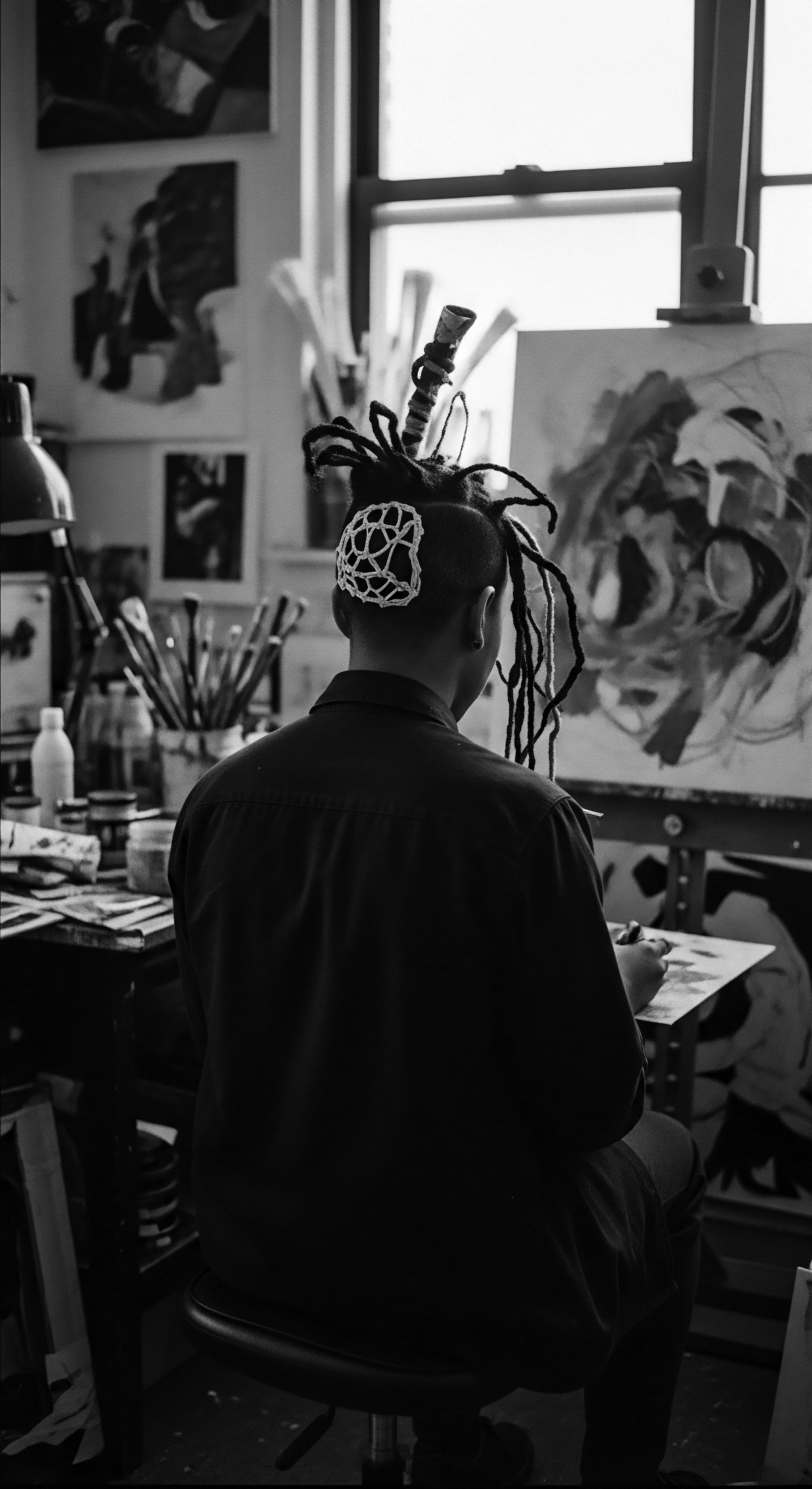
Roots
In the vibrant tapestry of human expression, few threads speak with such potent, interwoven meaning as hair. For individuals of Black and mixed-race ancestry, hair is more than keratin and pigment; it is a living archive, a whisper of generations, a testament to resilience. It is a conduit, connecting contemporary self-identity to deep ancestral practices and historical narratives. To truly understand the enduring heritage forged by the Tignon Laws, one must first feel the resonance of what hair meant before such decrees attempted to diminish its power.
These laws, enacted in 1786 in colonial Louisiana, sought to regulate the appearance of free and enslaved women of color, demanding they cover their hair with a headwrap, a tignon. The intent was clear ❉ to visibly mark these women as belonging to a subordinate class, to strip them of the visible symbols of their prosperity and allure.
Yet, the human spirit, especially when rooted in a profound sense of self and community, often finds ways to transform constraint into creation. The Tignon Laws, rather than extinguishing the brilliance of Black and mixed-race hair heritage, compelled a remarkable transformation, subtly reshaping care practices and reaffirming cultural expressions. This chapter invites us to delve into the very fibers of textured hair, exploring its fundamental biology and the rich lexicon that describes it, always keeping the ancestral echoes of defiance and devotion in mind.

Textured Hair’s Ancient Blueprint
The biological story of textured hair begins in the deep past, an evolutionary marvel shaped by the very environment that cradled early human existence. Afro-textured hair, characterized by its tightly spiraled, elliptical shape, evolved as an adaptation to intense sunlight and heat in Africa. This structure not only protected the scalp from ultraviolet radiation but also facilitated air circulation, providing a natural thermoregulatory system.
This inherent design speaks to a profound biological wisdom, a legacy of natural protection and inherent capability. Understanding this elemental biology forms the bedrock of our appreciation for its care.
From an ancestral perspective, hair was rarely a mere aesthetic choice. It functioned as a living identifier, a symbol of communal belonging, status, and spiritual connection. Before the transatlantic slave trade, various African societies used elaborate hairstyles to communicate marital status, age, wealth, and even ethnic identity.
Hair care rituals were communal, often extending for hours or even days, serving as moments of social bonding and the transmission of generational knowledge. Natural ingredients, such as Shea Butter, Coconut Oil, and various indigenous herbs, were central to these practices, prioritizing moisture retention and scalp health.
The story of textured hair is an ancient one, deeply intertwined with human evolution and cultural expression, long before colonial decrees attempted to dictate its display.

Language and Identity in Hair Classification
The ways we speak about textured hair carry immense historical weight. While modern classification systems often categorize hair types (e.g. 4C, 3A), it is important to remember that these systems, while useful for product application, often arose from contexts that once pathologized Black hair. The concept of “good hair” versus “bad hair,” for example, emerged from the brutal realities of slavery, where lighter skin and straighter hair were often granted preferential treatment.
The Tignon Laws, by attempting to erase the visible markers of Black women’s elaborate styles, inadvertently forced a reclamation of traditional head coverings, known as tignons, transforming them into emblems of pride and resistance. This act of defiance reasserted a lexicon of self-definition, where the “tignon” became a word synonymous with sartorial rebellion, rather than enforced subservience. It highlights how oppressive language and policies could paradoxically strengthen cultural identity, prompting the community to imbue existing terms with renewed, powerful meanings.
- Tignon ❉ A headwrap, originally mandated for Black women in colonial Louisiana to signify lower social status, but transformed into a symbol of defiance and beauty.
- Coils ❉ The tight, spring-like formations characteristic of many Afro-textured hair types, representing an inherent and unique structure.
- Protective Styling ❉ Hair practices that minimize manipulation and shield hair from environmental damage, echoing ancestral methods of care.

Ritual
The Tignon Laws, born from a colonial desire to diminish the visibility and societal standing of free and enslaved Black women in New Orleans, ironically catalyzed a profound transformation in hair practices. These laws, passed in 1786 by Spanish Governor Esteban Miró, aimed to force women of color to cover their exquisitely styled hair with simple head wraps, intending to visually link them to the enslaved class and curb their perceived social influence. Yet, within this restrictive framework, an enduring heritage of ingenuity and aesthetic rebellion took root, reshaping the art and science of textured hair styling.
Instead of yielding to the oppressive intent, Black and mixed-race women in Louisiana met the decree with breathtaking creativity. They transformed the mandated tignon into an art form, crafting elaborate headwraps from luxurious fabrics, adorned with jewels, ribbons, and feathers. This act of sartorial defiance was not merely a fashionable statement; it was a potent act of cultural preservation and self-affirmation. It reinforced the notion that true beauty and identity emanate from within, finding expression even amidst constraint.

Shaping Styles Through Resilience
The historical context of the Tignon Laws provides a lens through which to understand the ancestral roots of many modern protective styles. Before the laws, Black women sported intricate braids, twists, and elaborate coiffures that were both aesthetic and functional, preserving hair health. When the tignon became compulsory, these foundational techniques adapted.
Hair was still braided or coiled beneath the wraps, maintaining its integrity and allowing for continued growth, albeit hidden from public view. This practice inadvertently reinforced the value of protective styling, laying a hidden foundation for generations of hair care.
Consider the practice of Threading, a technique historically common in West Africa, where thread is used to wrap sections of hair, stretching it without heat. This ancestral method, passed down through oral tradition, served to elongate coils and protect strands. Similarly, various forms of Cornrows and Braids were not only expressions of tribal affiliation but also practical means of managing and preserving hair. The Tignon Laws compelled a continuation, and perhaps even an intensification, of these practices in private spaces, ensuring their survival and transmission.

Traditional Tools and Modern Echoes
The tools utilized in textured hair care tell their own story of heritage and innovation. While enslaved Africans were often stripped of their traditional grooming implements, they adapted, using available materials to maintain their hair. The Tignon Laws further emphasized the importance of effective underlying care, as the visible headwrap concealed what lay beneath. This prompted continued resourcefulness in tending to hair, making the most of limited resources and ancestral knowledge.
The spirit of self-sufficiency fostered during this period finds resonance in today’s natural hair movement, where individuals often seek out remedies and tools that align with a holistic approach to hair health. The contrast between pre-colonial African hair care, which involved natural butters, herbs, and powders for moisture, and the later introduction of harsh straightening methods during and after slavery, highlights a painful chapter of enforced conformity. The Tignon Laws, while a different form of oppression, similarly pushed Black women to find inventive ways to honor their hair, even if it meant doing so out of public sight.
| Historical Context Pre-colonial African hair as identity and status. |
| Impact on Textured Hair Heritage Diverse styling practices, natural product use, and communal rituals formed the bedrock of textured hair care heritage. |
| Historical Context Tignon Laws of 1786 in Louisiana. |
| Impact on Textured Hair Heritage Mandated head coverings, prompting women to transform tignons into statements of resistance and beauty, preserving hair beneath the wraps. |
| Historical Context Post-slavery shift to Eurocentric beauty standards. |
| Impact on Textured Hair Heritage Introduction of straightening tools and chemicals, creating a dichotomy of "good" and "bad" hair, challenging traditional practices. |
| Historical Context The evolution of textured hair care practices demonstrates a continuous thread of adaptation, innovation, and an unwavering commitment to cultural identity. |

Relay
The enduring heritage of the Tignon Laws extends beyond the realm of personal adornment, reaching into the deep currents of collective identity and communal agency. These colonial edicts, designed to dismantle the perceived social standing and inherent attractiveness of free women of color, ultimately became a crucible for resilience. The defiance expressed through the artful donning of tignons was a powerful declaration, a silent refusal to surrender an intrinsic part of self, culture, and ancestral lineage. This act of transforming an instrument of oppression into a symbol of pride continues to reverberate, shaping how textured hair is perceived and cared for today.
The laws of 1786 were not isolated incidents. They represent a historical continuum of regulating Black bodies and expressions, with hair often serving as a primary target. Even centuries later, discriminatory policies against natural Black hairstyles persist in schools and workplaces, underscoring a continuous struggle for recognition and acceptance. However, the legacy of the Tignon Laws offers a blueprint for how communities have historically met such challenges ❉ through creative reinterpretation and steadfast cultural affirmation.

How Did Tignon Laws Shape Hair as Political Statement?
The Tignon Laws inadvertently cemented the idea that Black hair, in its natural state or adorned with cultural meaning, carries a political charge. The very act of a woman of color in 18th-century New Orleans choosing a vibrant fabric or tying her tignon with a particular flair transformed a symbol of intended subjugation into one of visible defiance. This historical moment powerfully illuminated the connection between outward appearance and inner spirit, demonstrating how hair could be a site of both control and liberation.
The ability to transform a mandated covering into an expression of unique personhood became a powerful ancestral lesson. This resonates with later movements, such as the “Black Is Beautiful” era of the 1960s, where the Afro became a symbol of Black pride and a challenge to Eurocentric beauty norms.
One compelling example of this defiant heritage is found in the meticulous research on Creole women’s responses to the Tignon Laws. Historian Virginia M. Gould observes that Governor Miró’s intent to diminish the allure of these women backfired profoundly; rather, their embellished tignons drew even more attention, making them a “mark of distinction” (Gould, 1992, p. 102).
This highlights a crucial aspect of cultural resistance ❉ the ability to reinterpret and repurpose oppressive tools for self-definition. The visual spectacle created by these women underscored an inherent truth about textured hair ❉ its capacity for architectural styling, its sculptural qualities, and its deep connection to a heritage of adornment that transcended mere fashion.

Ancestral Wisdom and Modern Care
The deep knowledge of textured hair care, often passed down through generations, finds its roots in practices predating the colonial era. These traditional methods prioritized hair health and moisture, recognizing the unique needs of coils and kinks. In pre-colonial Africa, communal hair care rituals were central to societal life.
For instance, the Chadian Basara tribe, known for their remarkable hair length, traditionally uses Chebe Powder, a mixture of seeds and herbs applied to hair and braided to enhance length retention. This practice, passed down through mothers and grandmothers, exemplifies the enduring wisdom of ancestral approaches to hair care, focusing on preservation and vitality.
The imposition of the Tignon Laws, while forcing concealment, did not extinguish these deep-seated care traditions. Instead, it likely compelled their more private practice, ensuring that the knowledge of how to maintain and nurture textured hair continued through the lineage. The emphasis shifted, perhaps, from public display to personal upkeep and the preservation of hair beneath the coverings. This continuity demonstrates that the heritage of Black hair care is not solely about overt styles, but also about the underlying rituals that protect and sustain the hair itself, a silent rebellion against external pressures.
The legacy of the Tignon Laws influences contemporary understanding of textured hair, urging a recognition of its ancestral resilience. Today’s movements for natural hair acceptance are, in many ways, a continuation of that historical resistance, a public declaration of self-acceptance and a reaffirmation of the beauty that was once legislated into obscurity. The heritage calls for a care approach that respects hair’s natural inclinations, prioritizing its health and strength as a profound act of self-love and cultural honor.
The Tignon Laws, though designed to oppress, unintentionally spurred a powerful heritage of creative resistance, transforming mandated coverings into symbols of cultural pride and individual agency.

Reflection
The echoes of the Tignon Laws resonate through centuries, a somber reminder of attempts to diminish, yet also a resounding testament to the indomitable spirit. This chapter in history, unfolding in the vibrant, complex colonial New Orleans, speaks not just of legislative decree but of a profound, living heritage that refuses to be silenced or confined. It is a story etched into every curl, every coil, a testament to how adversity can inadvertently deepen the wellspring of cultural identity and ancestral wisdom.
The journey of Black and mixed-race hair, from ancient communal rituals to the defiant artistry of the tignon, and on to the present day’s celebrations of natural texture, reveals a continuous flow of resilience. The Tignon Laws sought to enforce a visible subjugation, a superficial marker of status, yet they prompted a powerful counter-movement. Women of color, with their inherent grace and profound understanding of adornment, took an object of oppression and imbued it with beauty, sophistication, and a quiet, knowing power.
They turned a symbol of constraint into a canvas for resistance, their headwraps becoming crowns rather than coverings. This transformation was a deeply personal act and a collective assertion of dignity that has rippled through generations.
Today, as we seek to understand the very “Soul of a Strand,” we honor this heritage by listening to its whispers. We acknowledge that the policing of Black hair, from historical laws to contemporary biases, is a thread woven into the fabric of systemic oppression. Yet, the Tignon Laws also highlight the unwavering human capacity for adaptation and creation. They remind us that true beauty flows from an inner source, finding its most compelling expression when it is authentic and self-defined.
The legacy passed down is one of discerning what is truly ours, of reclaiming narratives, and of celebrating the intrinsic beauty of textured hair in all its forms. It encourages a holistic approach to care, one that honors the biological blueprint of the strand while also acknowledging the profound cultural and spiritual significance it holds. The Tignon Laws, therefore, did not simply mandate covering; they inadvertently codified a continuing heritage of self-possession, inventive expression, and an enduring, vibrant connection to ancestral traditions of beauty and resistance.
The heritage of the Tignon Laws is a testament to the enduring power of cultural identity and creative resistance in the face of imposed restriction.

References
- Gould, V. M. (1992). Challenging the Code Noir ❉ The Politics of Race and Identity in New Orleans, 1786-1840. Journal of Social History, 25(3), 569-586.
- Byrd, A. D. & Tharps, L. (2014). Hair Story ❉ Untangling the Roots of Black Hair in America. St. Martin’s Publishing Group.
- Hooks, B. (1992). Black Looks ❉ Race and Representation. South End Press.
- Patton, M. F. (2006). African-American Hair Care ❉ An Examination of Cultural Significance and Market Trends. Sage Publications.
- Akbar, N. (1996). Light From Ancient Africa. African World Press.
- Tharps, L. (2001). Hair Story ❉ The Definitive Guide to Black Hair. St. Martin’s Press.
- Opoku-Agyemang, E. (2020). The Politics of Black Hair ❉ A Cultural Examination of Identity and Resistance. University of California Press.
- Davis, A. Y. (1981). Women, Race & Class. Vintage Books.
